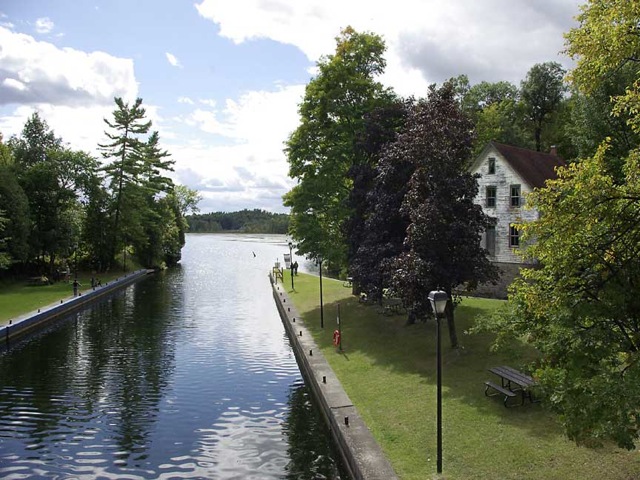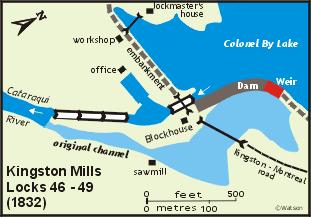Kingston Mills
Locks

Kingston Mills was the site of the first mill built on the
Rideau in 1784, and the locks that are there are still used today
as part of the Rideau Canal which is the oldest continuously
operated canal in North America. Once a series of rocky falls that
descended into swamps and marshes, it is now the last locks in the
Rideau Canal before hitting Lake Ontario.

The Rideau Canal starts in Ottawa, Canada’s Capital, and runs
through lakes and rivers connected by canals ending at Kingston
Mills 202 km. On June 27, 2007, the Rideau Canal was inscribed as a
UNESCO World Heritage Site.
In the Rideau area, the most recent period of glaciations (the
Wisconsin Period) first took hold about 90,000 years ago, and ended
about 13,000 years ago. As the ice retreated, the landscape
underwent progressive changes. Thirteen thousand (13,000) years
ago, the whole region, including present day Lake Ontario was under
ice. Twelve thousand (12,000) years ago, Lake Iroquois covered most
of the Rideau region, stretching all the way north to Ottawa.
Changes continued, driven to a large degree by isostatic rebound.
Now that the weight of the ice was gone, the land was rising. By
6,000 years ago isostatic rebound was complete and the region
resembled much like it does in present day.
The Rideau Lakes region rock formations consists of Precambrian
limestone (marble), gneiss, quartzite, granulite, migmatite and
granitic (quartz monzonite) plutons. These rocks are overlain in
many parts by more recent, Palaeozoic sedimentary rocks. The
Precambrian rocks in the Rideau region form part of what is known
as the "Frontenac Axis", a narrow section of the Canadian Shield
that links the Laurentian Plateau with the Adirondack Mountains of
New York.
In the Kingston area, the main types of rock formations that exist
are limestone, gneiss. Limestone is soft and has been eroded more
deeply than other rocks, and therefor forms the basins for most of
the large lakes of the region. In many areas it is almost pure
calcium carbonate, although inclusions are very common. Gneiss is a
generic descriptive term for a metamorphic rock with discontinuous
visible layering (foliation) which occurs when groups of platy or
elongate grains in separate lenses or streaks. It will often have
differential colouring with alternating streaks/bands of light and
dark minerals. In the Rideau Lakes region it is the most abundant
rock after crystalline limestone. The quarrying of limestone from
the region, and its use in buildings throughout Kingston, is what
gives the city the name “The Limestone City”.
The above information was written and published
by Mr. Ken Watson, who gave his approval for his material to be
used for this Earthcache.
To log this cache you must complete the following:
1. Take a photo at the posted coordinates holding your GPS with the
locks in the background.
In an email (through my profile), send me the answers to the
following questions. Do not post them in your logs. Logs without a
picture or an email will be deleted.
2. Using your GPS, measure the distance between lock 46 and lock
49.
3. Using your GPS, determine the total lift of the locks in
meters.
4. What are the four methods used to control the locks along the
Rideau Canal since it's creation?

If you enjoyed this earth cache, check out Weathervane's
Rideau Canal earth cache at the other end of the Rideau Canal
in Ottawa.